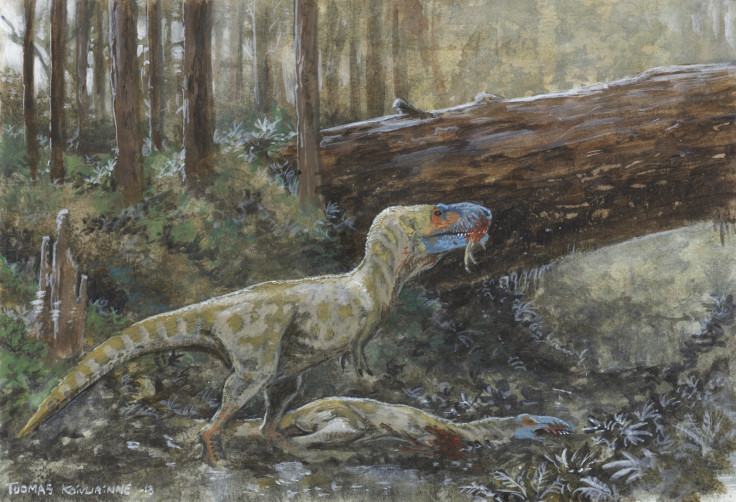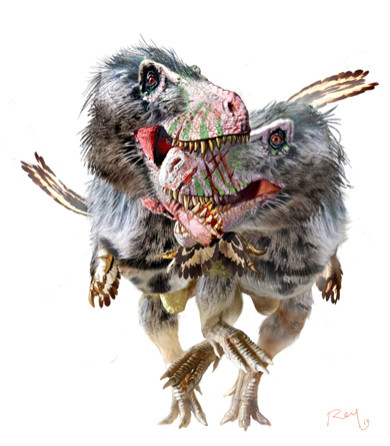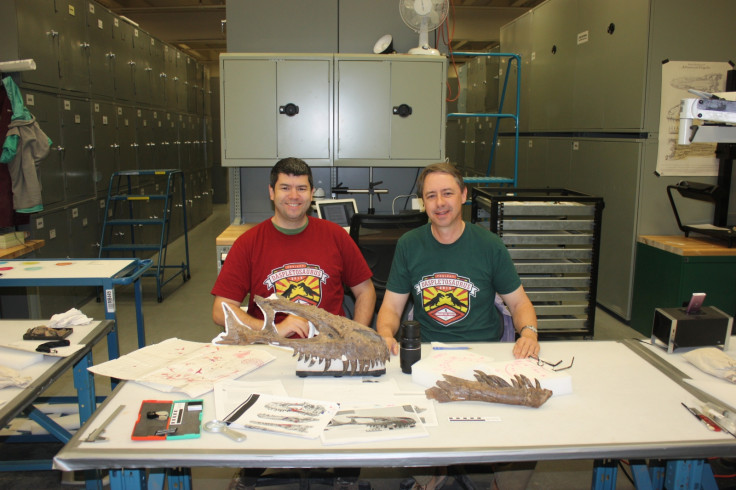Cannibal dinosaurs: T. Rex cousin Daspletosaurus fought and ate one another

Daspletosaurus dinosaurs were cannibals that fought one another – possibly even hunting members of their own species for food.
Analysis of a fossil found in the Dinosaur Provincial Park in Alberta, Canada, showed signs of intense combat during its life and that after it died, its jaw was chewed on and eaten by another daspletosaurus.
Scientists have long suspected that this species – a member of the tyrannosaurid family – were cannibals. They were fierce predators and scavengers living in western North America between 77 and 74 million years ago, but little is known about how they lived.
The fossil, first discovered in 1994, has now been analysed by researchers and is the first to show signs of both combat and cannibalism.
The study was published in the journal PeerJ and lead author David Hone, from Queen Mary, University of London, told IBTimes UK that the find provides a greater insight into how daspletosaurus lived.
"It's one of those things that is entirely mundane but entirely incredible – mundane in the sense that cannibalism (or eating other big carnivores you come across) is not unusual, it's rare but not unusual. But this case is very rare because these are big carnivores, so there's going to be one every few dozen kilometres, and they're not going to encounter one another on a daily basis. It's incredible because although you would expect that to happen, to find evidence of such a rare interaction is a big surprise. That's what is really neat."

The daspletosaurus was a juvenile when it died. It would have been about six metres long and weighed about 500kg. In comparison, fully grown adults would have weighed up to four tonnes.
Bite marks on its skull that healed were found to have been made by another daspletosaurs – several of the injuries were the shape of the teeth of tyrannosaurids. One of the marks in particular caused part of the skull to break off, leaving a circular tooth-shaped puncture through the bone.
The study said this skull, along with other daspletosaurus fossils showing similar injuries to the head, suggest the creatures partook in ritualistic combat – either standing side by side or face on.
"That's not generally what you'd see if you were looking at a typical aggressive interaction," Hone said. "If you watch two lions, they will face off and there will be a lot growling, but sooner or later one of them bolts and the other chases. Occasionally, you get two that are pretty evenly matched and they go hell for leather at each other. Mostly what they're doing is clashing heads.
"If you have a big carnivore with little arms and no antlers, they will clash by biting each other. It's notable we don't see bits around the legs – the rest of the body is clean but the head looks like someone's taken a hammer to it. If these things are running away from each other, why do we not see injuries to the hind or legs?"
Why this juvenile sustained so many injuries in its life remains a mystery, but there are several suggestions – it could have been attacked by an alpha male if the species was a social creature, it could have fought over food resources or it could have picked a fight with the wrong dinosaur.
"Young carnivores in particular are often really naïve," Hone said. "There's no shortage of footage of six-month-old lions trying to hunt a rhino and just getting nowhere with it until the rhino gets bored and hammers one of them – something no adult would do unless it was absolutely desperate."
The same mystery surrounds the creature's death. There is no evidence to suggest the daspletosaurus was killed by another tyrannosaurid, but a member of its family did come along and eat its jaw after it died.

Indeed, Hone said that while they do not think it was hunted by another daspletosaurus, it cannot be ruled out: "It's not an unreasonable assertion, but I doubt it was common or normal. Big carnivores will hunt and kill other carnivores and on rare occasions members of their own species, but I wouldn't think it common."
Alternatively, it could have just fallen over and broken its neck. Whatever the manner of death, researchers believe it fell into water or bog and that its face was the only part available to eat – there were no signs of damage to the rest of its body, which you would expect.
"We do have a good understanding of various carnivores – they follow a pattern in that you eat the stuff with all the meat on first. Things like the head are normally last. Those meaty bits don't show any bites on them at all. It looks like that stuff had either been eaten, or just decayed and fallen apart.
"Technically that post-mortem bite could have happened minutes before it keeled over and died. The reason we think not was the pattern of disarticulation of the carcass - the teeth had fallen out – that must have taken days if not weeks. And I doubt one killed the other then hung around for weeks before taking a bite out of it."
© Copyright IBTimes 2025. All rights reserved.






















